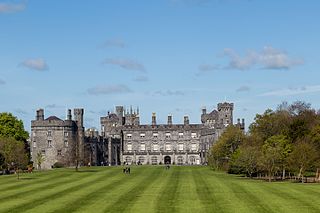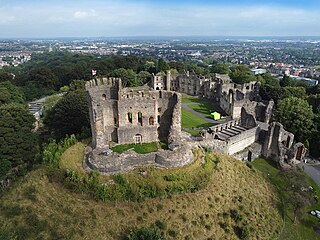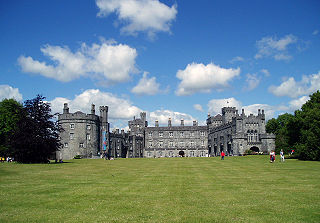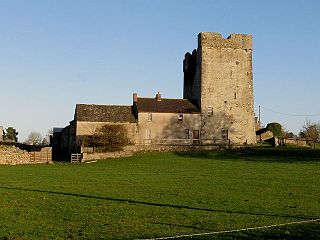
Foulksrath Castle (Irish : Caislean Ratha) is a 14th-century [1] Anglo-Norman tower house located in Jenkinstown in County Kilkenny, Ireland.

Foulksrath Castle (Irish : Caislean Ratha) is a 14th-century [1] Anglo-Norman tower house located in Jenkinstown in County Kilkenny, Ireland.
The castle is closely associated with both the De Frene and Purcell families. The estate and original fortified and moated dwelling were first built in 1349 and occupied by the De Frene family and it is thought that the castle derives its name from Fulco De Frene (d. 1349) who was in the military service of Edward III and fought at the Battle of Crecy and the Siege of Calais. In the early 15th century the current castle was built by the Purcell family, relatives to the De Frene's, after the estate came into their possession. [2] [3]
The Purcells sided with the Royalists during the English Civil War and had their estate confiscated by Cromwell. The estate was divided between three officers in Cromwell's army. One of them, Bradshaw, received the castle, but allowed the Purcells to continue living on the land. There were several inhabitants of the castle following Bradshaw's death, including the Dawson family and Moses Henshaw. A family of peasant farmers named Purcell were still living in the castle grounds in 1777 when the castle and lands were let to Thomas Wright.
William Ball Wright, genealogist and one of the first SPG Anglican missionaries to Japan, was born at the castle in 1843. [4] Lucy Olivia Wright, first Central Secretary of the Girls' Friendly Society, was born there in 1845. [5] The Wright family occupied the castle until 1861. [2] [6]

The Swift family (relatives of Jonathan Swift) have been associated with the castle since at least 1857. In that year, Godwin Meade Pratt Swift patented the first aircraft in Ireland. He called the device an "aerial chariot" and tested it by launching it from the top of Foulkrath Castle via a catapult with his butler as the pilot. The plane immediately nosedived to the ground. The butler survived, but with multiple broken bones. [7] [8] In a 1948 article in the Old Kilkenny Review, John Gibb wrote that the Swift family purchased the castle in 1898. [2] However, in a 1979 article in the same publication, John Brennan suggests they may have been the castle's owners, if not its residents, for a considerable time before that. [3]
In 1910, the castle was let to a Colonel Butler and his sister. After the death of Miss Butler, the castle lay empty and began to fall into ruin. [2] It was purchased from the Swift family by An Óige (the Irish Youth Hostel Association) in 1946 with community support. The purchase and cost of conversion into a youth hostel were met by a public appeal. [1] The Castle was managed by Jack Macken (Ernest J Macken), an artist who exhibited his oil paintings (and the work of local artists) in the gallery. Jack Macken left the Castle and the hostel closed in 2009 and Foulksrath Castle is now privately owned. [9]
Located about 12 km outside the medieval city of Kilkenny it is a well preserved and restored Norman Tower House. Most of the bawn (outer) wall and some ancillary structures also survive in addition to the main tower. A pitched roof has been added over the centre of the tower, though the open-air walk along the tower's crenellated battlement has been preserved and is still accessible. A narrow spiral staircase connects the four stories. The remains of a moat protect the outer walls of the tower. The moat is believed to have existed since the original structure was built some time in the early 13th century. It is probable that the earlier building was incorporated into the present structure. [2]
Several stories are in circulation as to the haunted nature of the castle and it was visited in 1992 by a BBC television crew of British ghost hunters. [9]
The first legend concerns a female ghost said to look out from the castle windows; she is purported to be the daughter of a former owner of the castle, who, unhappy with his daughter's choice of lover, had her locked away in a tower, where she either starved to death, or was put to death by her father, depending on the version. [10]
The second ghost apparently makes a yearly apparition on 29 November, and is supposedly a guard who fell asleep on duty and was thrown to his death from the ramparts of the castle in punishment. His footsteps can be heard as he wanders the castle to make amends for his carelessness.[ citation needed ]
The third legend concerns another female ghost, this time a woman who wanders the castle accompanied by the scent of wild flowers, or lilacs. [9]

Kilkenny is a city in County Kilkenny, Ireland. It is located in the South-East Region and in the province of Leinster. It is built on both banks of the River Nore. The 2022 census gave the population of Kilkenny as 27,184, the thirteenth-largest urban center in Ireland.

Dudley Castle is a ruined fortification in the town of Dudley, West Midlands, England. Originally a wooden motte and bailey castle built soon after the Norman Conquest, it was rebuilt as a stone fortification during the twelfth century but subsequently demolished on the orders of Henry II of England. Rebuilding of the castle took place from the second half of the thirteenth century and culminated in the construction of a range of buildings within the fortifications by John Dudley. The fortifications were slighted by order of the Parliament of England during the English Civil War and the residential buildings destroyed by fire in 1750. In the nineteenth and early twentieth century the site was used for fêtes and pageants. Today Dudley Zoo is located on its grounds.

Kilkenny Castle is a castle in Kilkenny, Ireland, built in 1260 to control a fording-point of the River Nore and the junction of several routeways. It was a symbol of Norman occupation, and in its original 13th-century condition, it would have formed an important element of the town's defences with four large circular corner towers and a massive ditch, part of which can still be seen today on the Parade.

Vice-Admiral Thomas Butler, 6th Earl of Ossory, KG, PC, PC (Ire) was an Irish soldier and politician. He was the eldest son of James Butler, 1st Duke of Ormond but predeceased his father and therefore never succeeded as duke.

Trim Castle is a castle on the south bank of the River Boyne in Trim, County Meath, Ireland, with an area of 30,000 m2. Over a period of 30 years, it was built by Hugh de Lacy and his son Walter as the caput of the Lordship of Meath. The Irish Government currently own and are in charge of the care of the castle, through the state agency The Office of Public Works (OPW).

Thomastown, historically known as Grennan, is a town in County Kilkenny in the province of Leinster in the south-east of Ireland. It is a market town along a stretch of the River Nore which is known for its salmon and trout, with a number of historical landmarks in the vicinity. Visitor attractions include Jerpoint Abbey, Kilfane Glen gardens, and Mount Juliet Golf Course. The town is in a civil parish of the same name.

Gowran is a town located on the eastern side of County Kilkenny, Ireland. The historic St. Mary's Collegiate Church is located in the centre of Gowran close to Gowran Castle. Gowran Park race course and Golf Course are located one km from the centre of Gowran. Gowran is located on the R448 regional road where it is crossed by the R702 regional road. The town is in a townland and civil parish and barony of the same name.
Walter Butler (1703–1783), also known as Walter Butler of Kilcash, and Walter Butler of Garryricken, was the de jure16th Earl of Ormond and 9th Earl of Ossory. He did not assume these titles, as he thought them forfeit as a result of the attainder of the 2nd Duke of Ormonde. In the peerage of Ireland, the titles were successfully claimed in 1791 by his son John, the 17th Earl.

Freshford is a village and former town in the barony of Crannagh, County Kilkenny, Ireland. It is 13 km north-west of Kilkenny city. The village is in a civil parish of the same name.
Christopher Plunket, 2nd Earl of Fingall and 11th Baron Killeen was an Irish politician and soldier. In 1641 he negotiated with the rebels on behalf of the Old English of the Pale and pushed them to join the rebellion. He fought for the rebels at the siege of Drogheda. He joined the Confederates and fought in their Leinster army, notably at Dungan's Hill. When the Confederates fused into the Royalist Alliance, he fought under James Butler, 1st Duke of Ormond in the Battle of Rathmines where he was wounded and taken prisoner. He died of his wounds two weeks later in captivity at Dublin Castle.
Richard Butler, 3rd Viscount Mountgarret (1578–1651) was the son of Edmund Butler, 2nd Viscount Mountgarret and Grany or Grizzel, daughter of Barnaby Fitzpatrick, 1st Baron Upper Ossory. He is best known for his participation in the Irish Confederate Wars on behalf of the Irish Confederate Catholics.

Huntington Castle, also known as Clonegal Castle, is a castle in Clonegal, County Carlow, Ireland, built in 1625.

Kilbline Castle is a fortified 16th century tower house in County Kilkenny in Ireland. It is set on the Kilbline Estate in the parish of Tullaherin, within the historical barony Gowran, approximately 1 mile southeast of Bennettsbridge. It is recorded as a protected (listed) structure by Kilkenny County Council.
Richard Butler of Kilcash (1615–1701) was an Irish soldier and landowner, the third son of Thomas Butler, Viscount Thurles and brother of James, 1st Duke of Ormonde. He sided with the Irish Confederacy at the Irish Rebellion of 1641. He scouted the enemy on the morning of the Battle of Cloughleagh. His descendants succeeded to the earldom of Ormond when the senior branch of the family failed in 1758.

Walter Butler of Nodstown, was the fourth son of James Butler, 9th Earl of Ormond and Lady Joan Fitzgerald. Nodstown is a townland in the civil parish of Ardmayle in the barony of Middle Third, County Tipperary. Moyaliff is a townland and a civil parish in the barony of Kilnamanagh Upper, County Tipperary.

Elizabeth Poyntz (1587–1673), known as Lady Thurles, was the mother of the Irish statesman and Royalist commander James Butler, 1st Duke of Ormonde.

Gowran Castle is located in the centre of Gowran, County Kilkenny, Ireland. The castle is a manor house and was fully restored between 2013 and 2014.

Fassadinin, sometimes written Fassadining, is a barony in the north of County Kilkenny, Ireland. It is one of 12 baronies in County Kilkenny. The size of the barony is 276.2 square kilometres (106.6 sq mi). There are 19 civil parishes in Fassadinin. The chief town today is Castlecomer. The N78 Kilkenny/Athy road bisects the barony. Fassadinin is currently administered by Kilkenny County Council.

The siege of Kilkenny was the isolation and capture of the fortified capital of the Irish Confederates by the New Model Army of the English Parliamentarians in March 1650 during the conquest of Ireland by Oliver Cromwell.

Cantwell's Castle is a tower house located in the townland of Sandfortscourt in County Kilkenny, Ireland. It served as the main residence for the head of the Cantwell family, While debated of who owned it in its final days the facts point to the Cantwell Family. Before a siege of the Cantwell castle from Oliver Cromwells army which led to Cromwells army being forced away with the Cantwells taking control even though two of the tree castles were significantly damaged.
{{cite book}}: CS1 maint: location missing publisher (link) CS1 maint: others (link)